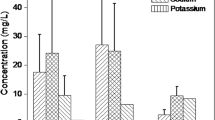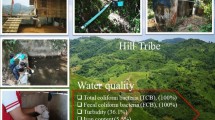Abstract
The physical (turbidity, color, smell, taste, pH, and conductivity) and geochemical properties (Ca, Mg, Na, Fe, Mn, Al, K, Cl−, HCO3 −, SO4 2−, Fe, Cu, Co, Ni, Zn, Cd, Pb, and Cr) of the drinking water in Gümüşhane city center were determined. This city center constitutes the study area. The pH levels of the water samples ranged from 6.3 to 8.2, and their conductivities ranged between 240 and 900 μS. These findings were concordant with the drinking water standards of the Turkey Standard Institute and the World Health Organization. The hardness of the water samples in the study area was between 18.1 and 115.1 °Fr. These samples were classified as extremely hard, hard, and quite hard. In addition, an assessment using the criteria for Inland Surface Water Classification indicated that considering certain parameters (pH levels, amount of Na, SO4 2−, Fe, Mn, Al, Co, Ni, Cu, and Cr), the samples belonged to class I (high quality) water. When Cl− amount and conductivity were considered, the samples belonged to the first and second classes (less polluted) of water. The water in the study area was generally classified as carbonated and sulfated (Ca + Mg > Na + K) water classes. This water contained more weak acids than strong acids (HCO3 − + CO3 2− > Cl− + SO4 2−). The pH levels (6.3–8.2) of the water in the study area were unrelated to the varying concentrations of metals in the water. Elements such as Fe, Ni, Cd, Pb, Zn, and Cu increase in the water through the water–rock interaction in the area in which water rises or through the mixture of water with either mine or industrial wastes. In addition, several water samples belonged to an acceptable water class for drinking and usage.





Similar content being viewed by others
References
Agilent Technology (2011) 4200 Microwave plasma-atomic emission spectrometer. https://www.chem.agilent.com/en-US/productsservices/Instruments-Systems/Atomic-Spectroscopy/4200-MP AES/Pages/default.aspx
Aksoy M (2000) Beslenme Biyokimyası. Hatipoğlu Yayınevi, Ankara, pp. 554–561
Aslan Z (2010) U–Pb zircon SHRIMP age, geochemical and petrographical characteristics of tuffs within calc-alkaline Eocene volcanics around Gumushane (NE Turkey), eastern Pontides. Neues Jahrbuch für Mineralogie-Abhandlungen 187(3):329–346
Asubiojo OI, Nkono NA, Ogunsua OA, Oluwole AF, Ward NI, Akanle OA, Spyrou NM (1997) Trace elements in drinking and ground-water samples in southern Nigeria. Sci Total Environ 208:1
Atabey E (2005) Tıbbı Jeoloji. TMMO Jeoloji Mühendisleri Odası Yayınları 124–134
Balaram V, Vummiti D, Roy P, Taylor C, Kar P, Raju AK, Abburi K (2013) Determination of precious metals in rocks and ores by microwave plasma-atomic emission spectrometry for geochemical prospecting studies. Curr Sci 104(9):1207–1215
Baysal A (1999) Beslenme. Hatipoğlu Yayınevi, Ankara, pp. 131–147
Bilgin M (2003) Niğde İli İçme Sularının Fiziksel, Kimyasal ve Bakteriyolojik Olarak İncelenmesi. Niğde Universitesi Fen Bilimleri Enstitüsü Çevre Mühendisliği Ana Bilim Dalı Uzmanlık Tezi, Niğde, 1–54
Bulut VN, Bayram A, Gündoğdu A, Soylak M, Tüfekçi M (2010) Assessment of water quality parameters in the stream Galyan, Trabzon, Turkey. Environ Monit Assess 165:1–13
Canik B (1998) Hidrojeoloji, Yeraltı Sularının Aranması. İşletilmesi, Kimyası. Ankara Üniversitesi, Fen Fakültesi, Jeoloji Mühendisliği Bölümü, Ankara
Doğan L (1981) Hidrojeolojide Su Kimyası, DSİ yayınları, Ankara, 178s
Eren M (1983) Gümüşhane-Kale Arasının Jeolojisi ve Mikrofasiyes İncelemesi, Yüksek Lisans Tezi, KTÜ, Fen Bilimleri Enstitüsü, Trabzon
Erguvanlı K, Yuzer E (1987) Yer Altı Suları Jeolojisi. İstanbul Teknik Universitesi Maden Fakültesi Yayınları, İstanbul
Gedik K, Verep B, Terzi E, Fevzioğlu S (2010) Fırtına Deresi (Rize)'nin Fiziko-Kimyasal Açıdan Su Kalitesinin Belirlenmesi. Ekoloji 19(76):25–35
Güler Ç, Çobanoğlu Z (1994) Su Kirliliği, Çevre Sağlığı Temel Kaynak Dizisi, Ankara, No: 12, ISBN 975-7572-60-8
Gültekin F (1998) Gümüşhane ve Bayburt yöresi mineralli su kaynaklarının hidrokimyası ve izotopik özellikleri, Doktora Tezi, KTÜ Fen Bilimleri Enstitüsü, Trabzon, 188
Güven İH (1993) 1/100000 Ölçekli Paftaların Jeolojisi Komisyonu. MTA Genel Mudurluğu, Ankara
Jankowski K, Yaob J, Kasiura K, Jackowska A, Sieradzka (2005) Multielement determination of heavy metals in water samples by continuous powder introduction microwave-induced plasma atomic emission spectrometry after preconcentration on activated carbon. Spectrochim Acta B 60:369–375
Kaya S, Akar F (1998) Metaller In ‘Veteriner Hekimliğinde Toksikoloji’. Ed. by Kaya S.
Lenntech (2014). http://www.lenntech.com/ro/water-hardness.htm
Ministry Forest and Water Works (MFW) (2012) Yüzeysel Su Kalitesi Yönetim Yönetmeliği (Inland Surface Water Classification), Orman ve Su İşleri Bakanlığı, Sayı: 28483, Ankara
Pelin S (1977) Alucra (Giresun) Güneydoğu Yöresinin Petrol Olanakları Bakımından İncelenmesi, Doktora Tezi, KTÜ Yer Bilimleri Fakültesi, No:13 Trabzon
Sipahi F (2011) Formation of skarns at Gümüşhane (northeastern Turkey). Neues Jahrbuch für Mineralogie-Abhandlungen 188(2):169–190
Soylak M, Aydın FA, Saraçoğlu S, Elçi L, Doğan M (2002) Chemical analysis of drinking water samples from Yozgat, Turkey. Pol J Environ Stud 11(2):151–156
Soylak M, Doğan M (1996) Chemical analysis of spring waters from the Kayseri-Yozgat district, Turkiye. Fresenius Environ Bull 5(1–2):13–20
Soylak M, Doğan M (2000) Su kimyası. Erciyes Üniversitesi Yayınları Yayın No: 120, Kayseri, 79–83
Soylak M, Elçi L (2000) Solid phase extraction of trace metal ions in drinking water samples from Kayseri-Turkey. Journal of Trace and Microprobe Techniques 18(3):397–403
Tokel S (1972) Stratgraphical and volcanic history of the Gümüşhane region, N.E. Turkey, Universty Colloge, London.
Topuz G, Altherr R, Siebel W, Schwarz WH, Zack T, Hasözbek A, Barth M, Satır M, Şen C (2010) Carboniferous high-potassium I-type granitoid magmatism in the eastern Pontides: the Gümüşhane pluton (NE Turkey). Lithos 116:92–110
TS 3790 (1988) Su Kalitesi-Alkalilik Tayini. Türk Standartları Enstitüsü (TSE)
TS 4161 ISO 9297 (1998) Su Kalitesi-Klorür Tayini-Kromat İndikatörü Yanında Gümüş Nitrat ile Titrasyon (Mohr Metodu), Türk Standartları Enstitüsü (TSE)
TS 5095 (1987) Suyun Analiz Metotlari-Sülfat Tayini- Gravimetrik, Türbitimetrik ve Titrimetrik Metotlar (Methods for the analysis of water-determination of sulfate content gravimetric, turbidimetric and titrimetric methods), Türk Standartları Enstitüsü (TSE)
TS 266 (2005). Water intended for human consumption. Türk Standartları Enstitüsü (TSE), Ankara Turkey (in Turkish).
Tuncay H (1994) Su Kalitesi. E.U., Ziraat Fakültesi Yayınları, İzmir 243s
Tüzen M, Soylak M, Parlar K (2005) Cadmium and lead contamination in tap water samples from Tokat, Turkey. Bull Environ Contam Toxicol 75(2):284–289
Vysetti B, Vummiti D, Roy P, Taylor C, Kamala CT, Satyanarayanan M, Kar P, Subramanyam KSV, Raju AK, Abburi K (2014) Analysis of geochemical samples by microwave plasma-AES. Atomic Spectroscopy 35(2):65–78
WHO (World Health Organization) (2014) Guidelines for drinking water quality, Geneva: http://www.permoakdeniz.com/icme-suyu-standardi.html
Yılmaz F (2004) Mumcular Barajı (Mugla-Bodrum)’nın Fiziko-Kimyasal Ozellikleri. Ekoloji 13(50):10–17
Yılmaz Y (1972) Geology of the Gümüşhane granitoid (petrograpy). İstanbul Üniversitesi Fen Fakültesi Seri B, İstanbul, pp. 157–172
Acknowledgments
This study is part of the second author’s Master of Science thesis. The authors thank Ali Gündoğdu and Cemalettin Baltacı of the Gümüşhane University for the water analysis. Thanks are due to Abdullah M. Al-Amri for editorial handling. We are also grateful to the two reviewers for their help in the general improvement of the manuscript.
Author information
Authors and Affiliations
Corresponding author
Rights and permissions
About this article
Cite this article
Sipahi, F., Uslu, S. Investigation of the quality and physical-geochemical characteristics of the drinking water in Gümüşhane (Turkey) city central. Arab J Geosci 9, 600 (2016). https://doi.org/10.1007/s12517-016-2620-6
Received:
Accepted:
Published:
DOI: https://doi.org/10.1007/s12517-016-2620-6




